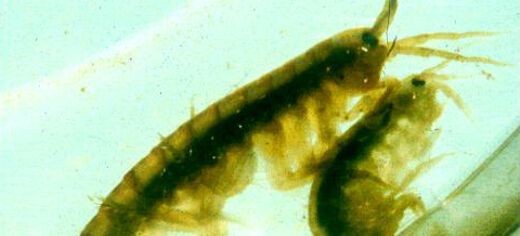Parasites can play an important role in driving cannibalism, according to a new research which looked at cannibalism among freshwater shrimp in Northern Ireland.
Researchers from the University of Leeds, Queen’s University Belfast and Stellenbosch University in South Africa found a tiny parasite, Pleistophora mulleri, not only significantly increased cannibalism among the indigenous shrimp Gammarus duebeni celticus but made infected shrimp more voracious, taking much less time to consume their victims.
Dr Alison Dunn, Reader in Evolutionary Biology in the University of Leeds’ Faculty of Biological Sciences, who led the study, said: “Cannibalism is actually fairly common in nature. Our work is the first study to ask if cannibalism is affected by being parasitised.”
The research, published in Royal Society Open Science today, reports that although consumption of juveniles by adults is a normal feature of the shrimp’s feeding patterns, shrimp infected with the parasite ate twice as much of their own kind as uninfected animals.
They attacked juvenile shrimp more often and consumed them more quickly than did uninfected shrimp.
Mandy Bunke, a PhD student at the University of Leeds who was the key researcher on the study, said: “Although the parasite is tiny—similar in size to a human red blood cell—there are millions of them in the host muscle and they all rely on the host for food. This increased demand for food by the parasites may drive the host to be more cannibalistic.”
Dr Dunn added: “The parasite is quite debilitating. It takes over huge areas of the muscle, so instead of a nice transparent shrimp you get quite a chalky appearance because of muscles packed with the parasite. Interestingly, our group has also found previously that infected shrimp may be able to catch and eat less prey of other animal species. Perhaps cannibalism of smaller shrimp is the only way these sick animals can survive.”
The latest study also found that uninfected adult shrimp were less likely to cannibalize infected juvenile shrimp than uninfected juveniles.
Dr Dunn said: “The parasite is passed to its new host either when it dies and is eaten by another shrimp, or when one shrimp cannibalises another. But we observed that uninfected shrimp avoid parasitised food and that is good for the shrimp as it means that they can obtain food through cannibalism but still avoid parasitic infection. Infected shrimp don’t avoid infected juveniles. They consume infected and uninfected juveniles. This may be is because they are more hungry or because they are already infected so there is no incentive to avoid eating infected juveniles.”
Dr Dunn said: “Our research does not suggest any link between parasites and human cannibalism. There is evidence that parasites can affect human behaviour. A study led by Dr Glenn McConkey, also of the University of Leeds Faculty of Biological Sciences, has shown that the parasite Toxoplasma gondii directly affects the chemistry of the human brain. However, cannibalism for the shrimp, unlike in humans, is a significant source of food even in uninfected animals. It seems unlikely that a parasite would be under evolutionary pressure to influence cannibalism in humans.”
However, the study is important to understanding the extent of parasites’ influence on biological systems. The Gammarus duebeni celticus, the subject of the study, is being replaced in Irish waterways by the invasive species Gammarus pulex, which is native to Great Britain. The Open Science study suggests that the parasite Pleistophora mulleri may be playing a role in weakening Gammarus duebeni’s resistance.
Further information
Dr Alison Dunn at Leeds and Professor Jaimie Dick at Queen’s University Belfast are available for interview.
Images of Gammarus duebeni celticus are available from the University of Leeds media team on request.
Contact: Chris Bunting, Senior Press Officer, University of Leeds; phone: +44 113 343 2049 or email c.j.bunting@leeds.ac.uk.
The full paper: Mandy Bunke et al., ‘Eaten alive: cannibalism enhanced by parasites,’ is published in Royal Society Open Science (2015) and is available at
http://dx.doi.org/10.1098/rsos.140369 (DOI: 10.1098/rsos.140369 ).
